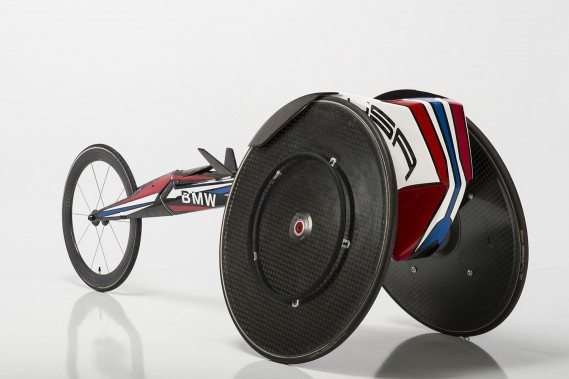BMW Designworks has revealed the new 3D printed wheelchairs it created for the US Paralympic Track and Field team in a new TV advert.
DesignworksUSA, the BMW-owned creative consultancy, is the Official Mobility Partner of the United States Olympic Committee. It worked with the team to tailor each and every chair to the specific athlete to help them give their best in Rio de Janeiro.
Paralympian Josh George competes in a number of T53 events, ranging from sprints to marathons. He has won five Paralympic medals, a number of international marathons, he’s a World Champion, world record holder and a motivational speaker. Here he talks about the difference that the 3D printed wheelchair could make to his latest campaign.
From the winter to the Paralympics
BMW’s consultancy worked with the US bobsled team at the 2014 Winter Olympics in Sochi. The lightweight, streamlined sled that additive manufacturing helped to create took the team to three medals. Now it has turned its attention to wheelchairs for the Paralympic squad.
The Paralympics include a vast array of sports, from road racing through to basketball and fencing. Each sport places its own unique demands on the chairs that the athletes use and that means that 3D printing should have an increasing level of influence on the games over time.
This year cyclist Denise Schindler will use a 3D printed leg and now the US team will use the wheelchairs. They might look ostensibly similar, but under the skin the 3D printed wheelchairs are a world away from their traditionally manufactured counterparts.
A 3D printed aerodynamic advantage
Designworks took a 3D scan of the athlete in their chair. Then it created 3D models, including the athlete in the procedure, that could fine tune the aerodynamics. The 3D modelling process helped them find a way to reduce drag by up to 15% with a series of small changes to the frame and the user’s position.
Designworks USA Associate Director Brad Cracchiola told Fast Company: “It’s not necessarily a revolution for these guys, but you want to give them every little edge. If they’re pushing into a headwind, or they hit a hill at 45 miles per hour, at those points, they’re in a tucked position trying to get as much speed as they can.”
Comfort is the key
For an athlete to give their best performance, user comfort is a crucial. This redesign focused on tailoring the chairs to the athlete so that they felt comfortable, they could rely on their chair to feel the same each and every time and they could focus purely on their performance.
“There’s an interesting psychology to this,” he said. “The comfort of your equipment, the repeatability, when you have that mold, you know how it’s going to feel every time. That’s one less thing for the athlete to think about.”
Carbon fiber can make a difference
The wheelchairs were printed from carbon fiber, which is lighter than aluminium and also provides greater torsional rigidity and stiffness. With less flex in the frame, more of the power the athlete puts through wheels goes into forward motion.
It’s another subtle difference, but over the course of a long event then keeping the wheels perfectly aligned and preventing shocks going through the frame can be the difference between winning and losing. As can the rapid prototyping aspect that allows the designers to print a selection of options that the athletes can test in real world conditions to find the best solution.
The US Paralympic team will go for gold in Rio de Janeiro, powered by BMW, and we wish these extraordinary athletes the very best of luck.




